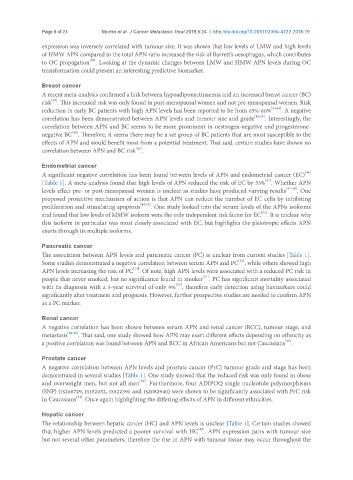Page 320 - Read Online
P. 320
Page 6 of 23 Monks et al. J Cancer Metastasis Treat 2019;5:24 I http://dx.doi.org/10.20517/2394-4722.2018.79
expression was inversely correlated with tumour size. It was shown that low levels of LMW and high levels
of HMW APN compared to the total APN ratio increased the risk of Barrett’s oesophagus, which contributes
[38]
to OC propagation . Looking at the dynamic changes between LMW and HMW APN levels during OC
transformation could present an interesting predictive biomarker.
Breast cancer
A recent meta-analysis confirmed a link between hypoadiponectinaemia and an increased breast cancer (BC)
[39]
risk . This increased risk was only found in post-menopausal women and not pre-menopausal women. Risk
reduction in early BC patients with high APN levels has been reported to be from 65%-80% [40,41] . A negative
correlation has been demonstrated between APN levels and tumour size and grade [42,43] . Interestingly, the
correlation between APN and BC seems to be more prominent in oestrogen-negative and progesterone-
[44]
negative BC . Therefore, it seems there may be a set group of BC patients that are most susceptible to the
effects of APN and would benefit most from a potential treatment. That said, certain studies have shown no
[45]
correlation between APN and BC risk .
Endometrial cancer
A significant negative correlation has been found between levels of APN and endometrial cancer (EC)
[46]
[47]
[Table 1]. A meta-analysis found that high levels of APN reduced the risk of EC by 53% . Whether APN
levels effect pre- or post-menopausal women is unclear as studies have produced varying results [47-49] . One
proposed protective mechanism of action is that APN can reduce the number of EC cells by inhibiting
proliferation and stimulating apoptosis [49,50] . One study looked into the serum levels of the APNs isoforms
[51]
and found that low levels of MMW isoform were the only independent risk factor for EC . It is unclear why
this isoform in particular was most closely associated with EC, but highlights the pleiotropic effects APN
exerts through its multiple isoforms.
Pancreatic cancer
The association between APN levels and pancreatic cancer (PC) is unclear from current studies [Table 1].
[52]
Some studies demonstrated a negative correlation between serum APN and PC , while others showed high
[53]
APN levels increasing the risk of PC . Of note, high APN levels were associated with a reduced PC risk in
[54]
people that never smoked, but no significance found in smoker . PC has significant mortality associated
with its diagnosis with a 5-year survival of only 9% , therefore early detection using biomarkers could
[55]
significantly alter treatment and prognosis. However, further prospective studies are needed to confirm APN
as a PC marker.
Renal cancer
A negative correlation has been shown between serum APN and renal cancer (RCC), tumour stage, and
metastasis [56-58] . That said, one study showed how APN may exert different effects depending on ethnicity as
[59]
a positive correlation was found between APN and RCC in African Americans but not Caucasians .
Prostate cancer
A negative correlation between APN levels and prostate cancer (PrC) tumour grade and stage has been
demonstrated in several studies [Table 1]. One study showed that the reduced risk was only found in obese
[60]
and overweight men, but not all men . Furthermore, four ADIPOQ single nucleotide polymorphisms
(SNP) (rs266729, rs182052, rs822391 and rs2082940) were shown to be significantly associated with PrC risk
[61]
in Caucasians . Once again highlighting the differing effects of APN in different ethnicities.
Hepatic cancer
The relationship between hepatic cancer (HC) and APN levels is unclear [Table 1]. Certain studies showed
[62]
that higher APN levels predicted a poorer survival with HC . APN expression pairs with tumour size
but not several other parameters, therefore the rise in APN with tumour tissue may occur throughout the

